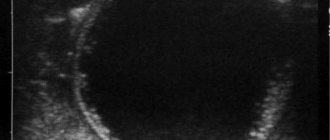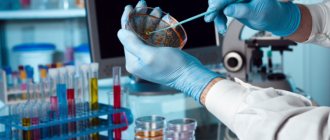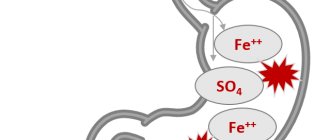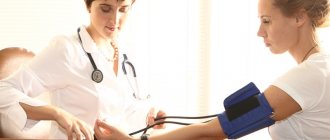Causes of glucose imbalance
There are two types of blood sugar disorders:
- Hyperglycemia: glucose level exceeds 5.5 mmol/l. In persons over 60 years of age, a level of 5.9-6.3 mmol/l is considered normal.
- Hypoglycemia: glucose level below 3.3-3.5 mmol/l.
Each of these conditions has its own causes and provoking factors, which should be discussed separately.
Hyperglycemia
- Diabetes;
- neoplasms in the liver;
- severe neuropsychological stress;
- regular overeating (gluttony);
- lack of B vitamins;
- uncontrolled use of certain groups of medications: antidepressants, β-blockers, diuretics, corticosteroids, etc.
Hypoglycemia
- excessive physical activity leading to excess glucose consumption;
- violations of the rules for taking glucose-lowering medications;
- Irregular meals or poor diet;
- chronic liver, kidney and/or heart failure;
- hepatitis or insulinoma (pancreatic tumor);
- lack of hormones: glucagon, cortisol, somatropin;
- congenital disorders of insulin secretion;
- chronic alcoholism;
- anorexia.
Irkutsk City Clinical Hospital No. 9
Memo for the patient:
What to do to prevent the development of hyperglycemia and diabetes.
Facts about hyperglycemia and diabetes:
- There is a new case of diabetes every 20 minutes in the United States, and every forty minutes in Europe.
- Currently, the prevalence of overt diabetes mellitus among the population of economically developed countries reaches 4-7%. However, mass surveys have shown that there are twice as many patients with latent forms of diabetes.
- In individuals whose body weight exceeds the norm by 20%, diabetes mellitus is detected 10 times more often than in the population. Among people with severe obesity, the incidence of diabetes increases 30 times. The combination of several risk factors has been shown to increase the likelihood of developing clinical diabetes mellitus by approximately 29 times.
- The mortality rate among patients with diabetes mellitus who have suffered a myocardial infarction is 1.5 - 2.5 times higher than in persons without carbohydrate metabolism disorders.
Hyperglycemia (high blood sugar) occurs when blood sugar levels rise above normal. This occurs when the pancreas does not produce enough insulin or it does not work as well as it should. Then glucose, the main source of energy, is not absorbed by the cells, the cells begin to “starve”, and weakness develops; blood sugar, on the contrary, rises and draws water from the cells - thirst appears; Due to metabolic disorders, small and large vessels of the brain, heart, kidneys and other organs are quickly affected, and immunity is impaired.
Check if you have any signs of diabetes?
- strong thirst;
- drowsiness;
- blurred vision;
- frequent urination;
- irritability;
- itching (especially in the perineal area);
- dry skin, pustules and boils;
- increased appetite;
- sticky urine.
If blood glucose levels are too high, diabetes develops. In 95% of cases, this is type 2 diabetes, which occurs more often in people over 40 years of age who lead an unhealthy lifestyle. Look, maybe you also have risk factors for this dangerous disease?
- age over 45 years;
- diabetes mellitus in relatives;
- excess body weight;
- low physical activity;
- accidentally detected elevated glucose levels during examination;
- increased blood sugar during pregnancy and the birth of a large fetus;
- high blood pressure, above 140/90 mmHg;
- changes in cholesterol metabolism (low high-density lipoprotein levels ≤ 0.9 mmol/l and/or triglyceride levels ≥ 2.82 mmol/l);
- polycystic ovary syndrome;
- suffered strokes, heart attacks.
If something has alerted you, then the only way to check whether you have diabetes or not is to do a blood test: determine your glucose level on an empty stomach and/or 2 hours after taking 75 grams of glucose. The frequency of examination depends on the risk group you fall into.
| Risk group | Frequency of examination |
| Persons over 45 years of age | At least once every 3 years; |
| Combination of 3 or more risk factors | At least once every 3 years; |
| Persons with prediabetes, especially those who are overweight | Once every 1-2 years |
Capillary blood glucose level
| Carrying out analysis | Norm | Prediabetes | Diabetes |
| On an empty stomach | 3,3-5,5mmol/l | 5,5-6,1mmol/l | > 6,1mmol/l |
| 2 hours after taking 75 grams of sugar or any time of the day | < 7,8mmol/l | 7,8-11,1mmol/l | >11,1mmol/l |
You can also check your risk of developing prediabetes or type 2 diabetes in the next 10 years using the following questionnaire:
- Age: up to 45 years (0 points), 45-54 years (2 points), 55-64 years (3 points), over 65 years (4 points).
- Body mass index - height (m) divided by body weight (kg) squared, for example, with a height of 165 cm and a weight of 73 kg, the index is 73: (1.65 m X 1.65) = 26.8 = 27 kg /m2: below 25 kg/m2 (0 points), 25-30 kg/m2 (1 point), more than 30 kg/m2 (3 points).
- Waist circumference - measured under the ribs at the level of the navel. Men: less than 94 cm (0 points), 94-102 cm (3 points), more than 102 cm (4 points). Women: less than 80 cm (0 points), 80-88 cm (3 points), more than 88 cm (4 points).
- How often do you eat vegetables, fruits or berries? Every day (0 points), not every day (1 point);
- Do you exercise regularly? Do you exercise 30 minutes every day or 3 hours during the week? Yes (0 points), no (2 points);
- Have you ever taken medications regularly to lower your blood pressure? No (0 points), yes (2 points).
- Have you ever had your blood sugar level higher than normal (during preventive examinations, during illness or pregnancy)? No (0 points), yes (5 points).
- Did your relatives have type 1 or type 2 diabetes? No (0 points), yes: grandparent, aunt/uncle, cousins (3 points), parents, brother/sister or own child (5 points).
TOTAL POINTS__________________________
Your risk of developing type 2 diabetes over 10 years is:
| Total points | DM risk level 2 | Probability of developing type 2 diabetes |
| Less than 7 | Low risk | 1 in 100 (1%) |
| 7-11 | Slightly elevated | 1 in 25 (4%) |
| 12-14 | Moderate | 1 out of 6 (17%) |
| 15-20 | High risk | 1 out of 3 (33%) |
| more than 20 | Very high risk | 1 out of 2 (50%) |
- If you score less than 12 points, you are in good health and should maintain a healthy lifestyle.
- If you score 12-14 points, you may have prediabetes. You should ask your doctor about lifestyle changes.
- If you score 15-20 points, you may have prediabetes or type 2 diabetes. It is advisable for you to check your blood sugar levels. You may need to change your lifestyle and may need medication to control your blood sugar levels.
- If you score more than 20, you most likely have type 2 diabetes. You should regularly check your blood sugar levels with a glucometer. You need to change your lifestyle and need medications to control your blood sugar levels.
Diabetes prevention should start in the kitchen.
About 80% of patients with type 2 diabetes are overweight, which weakens the effect of insulin. Therefore, the primary task in this situation is to reduce weight (not to the full norm, but 5-10% below the original) and maintain it at this level through continued dieting. This diet should be tasty, varied, not cause a feeling of hunger, but contain fewer calories than the patient consumed before; for this you just need to follow some rules:
These products should be sharply limited:
a) Severely increases blood sugar:
- Sugar, honey, dried fruits, fruit juices, confectionery, sweets, jam, lemonades (“Fanta”, “Pepsi”, etc.), natural kvass.
- Semolina porridge, mashed potatoes, heavily boiled porridge.
b) Contain a lot of calories:
- Butter, vegetable oil (especially in salads, vinaigrettes and when heating food), sour cream, mayonnaise, butter substitutes (Rama, etc.).
- Lard, sausages and sausages, sausages and pates, smoked meats, fatty meat, fatty fish, meat by-products (liver, liver), chicken legs, poultry skin.
- Fatty (“yellow” and processed) cheeses, cream, fatty cottage cheese.
- Nuts and seeds, pies and pies.
The consumption of these products should be halved:
- Bread (black or white), cereals (rice, buckwheat, oatmeal, etc.).
- Potatoes, pasta, corn and soy products, crackers, crackers (unsweetened), etc.
- Fruits: distribute throughout the day.
- Candies, waffles, etc.: as an “infrequent treat” (once a week).
- Acceptable in moderation: lean meat, fish, cottage cheese.
Increase consumption:
- Vegetables (but without added fat) in the form of vegetable side dishes : cabbage, cauliflower, carrots, beets, turnips, radishes, cucumbers, tomatoes, greens.
- Drinks without sugar: mineral water, tea).
| Physical activity to prevent diabetes Aerobic exercises are indicated, such as: walking, jogging, swimming, tennis, cycling, rhythmic gymnastics (promote more intense absorption of oxygen by the body and are beneficial for the heart and blood vessels). Aerobic physical activity ensures maximum oxygen delivery to organs and tissues, so they must be performed at a certain heart rate, which is calculated individually for each person.
|
Symptoms of hyperglycemia
The following clinical signs indicate elevated blood sugar:
- constant strong unquenchable thirst, often accompanied by a feeling of dry mouth;
- slow healing of wounds, as well as their increased tendency to infection and suppuration;
- frequent urination with small volumes of single urine output;
- regular occurrence of infectious diseases, especially those affecting the mucous membranes (for example, candidiasis);
- causeless loss of body weight;
- decreased visual acuity - sometimes temporary;
- noticeable deterioration in the condition of the skin and hair;
- chronic fatigue, increased fatigue;
- cardiac arrhythmia;
- causeless irritability and nervousness.
Treatment of diabetes
Diabetes mellitus belongs to the group of endocrine diseases.
The pathology develops when the production or action on the tissue of insulin, a hormone of the pancreatic islet apparatus, that promotes the absorption of glucose, is impaired. Sugar can accumulate in the blood (hyperglycemia) and urine (glycosuria). Long-term disruption of glucose utilization leads to disruption of all types of metabolism. The pathology of the islet apparatus often occurs with disorders of different degrees of severity on the part of other organs and systems. Characterized by lesions of small vessels, retina, kidneys, and nervous system.
Typically, diabetes mellitus has quite pronounced metabolic abnormalities and is easily diagnosed. It is more difficult to identify the disease in the initial and preclinical stages, when the patient’s complaints are minimal or absent. This requires in-depth, targeted research. Detection of the disease in the early stages is an important condition for effective treatment and prevention of complications.
If you need to undergo a comprehensive examination for endocrinopathy or are looking for where to treat diabetes mellitus in Moscow, contact the Federal Scientific and Clinical Center of the Federal Medical and Biological Agency. Our patients have at their disposal experienced endocrinologists and a laboratory with modern diagnostic equipment for conducting high-precision studies.
Signs of hypoglycemia
A decrease in blood sugar levels has fairly clear symptoms, and therefore does not pose any difficulties in diagnosis:
- increased sweating;
- tremor of the limbs;
- high blood pressure;
- chronic tachycardia;
- frequent and causeless nausea;
- constant feeling of weakness, frequent dizziness;
- persistent feeling of hunger;
- pronounced pallor of the skin;
- frequent headaches;
- blurred vision, double vision of visible objects;
- tingling or “ants crawling” sensations throughout the body;
- decreased concentration.
Factors influencing the development of diabetes mellitus
There are two key points in the mechanisms of development of diabetes mellitus, on the basis of which the disease is divided into types:
- Low insulin production by intrasecretory pancreatic cells.
- Impaired ability of the hormone to act on the body, cell insensitivity to insulin.
If there is insufficient insulin production, type 1 diabetes develops. It is based on the progressive destruction of the islets of Langerhans (intrasecretory cells of the pancreas). This occurs as a result of autoimmune processes in the body - antibodies to insulin, secretory cell structures, and enzymes are produced.
Provoking factors for the development of autoimmune disorders can be:
- viral infections;
- malnutrition during pregnancy and breastfeeding;
- unfavorable environmental conditions;
- the effect of stress.
Type 1 diabetes is more often diagnosed in young people. The first manifestations of pathology occur when the death of intrasecretory cells reaches more than 80%. The disease occurs with a high risk of complications; all types of metabolism are significantly affected.
Type 2 diabetes occurs when tissue receptors are resistant to the action of insulin. In this case, the hormone is reproduced in normal or slightly reduced quantities. The mechanism of such disorders is associated with an initially defective structure of insulin (hereditary predisposition) or acquired changes, as a result of which signal transmission from receptors to the internal structures of the cell is disrupted.
The development of type 2 disease can be provoked by:
- improper diet, overeating;
- sedentary lifestyle;
- hypertonic disease;
- alcohol abuse;
- age-related changes;
- obesity;
- uncontrolled medication use.







